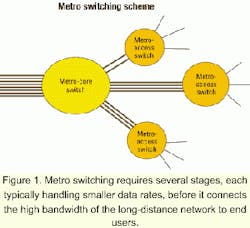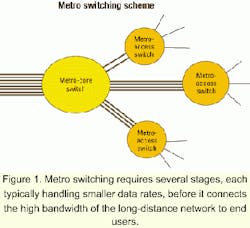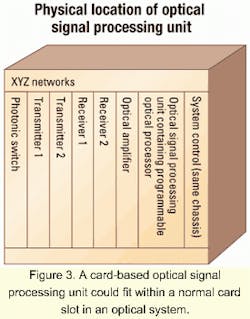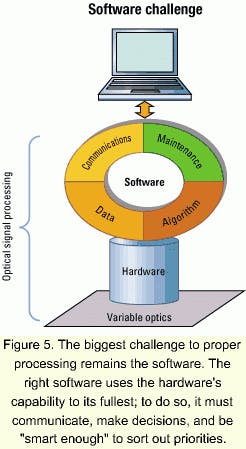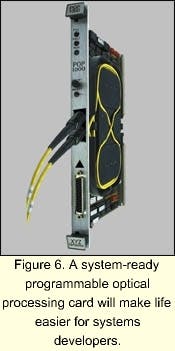Programmable optical processors accelerate the evolution toward dynamic WDM
Lack of adequate switching is hindering metro networks; programmable optical processors can help.
HIMANSHU VAISHNAV and DAN YANG, DowsLake Microsystems Corp.
WDM transmission has played a key role in increasing the bandwidth of telecommunications networks. Yet, as important as this advance has become, optics remains for the most part purely a transmission technology, and electronics continues to handle switching and processing of the bits. In recent years, system integrators have developed optical systems capable of providing more functions than just carrying data from point A to point B. Major advantages are to be gained by incorporating switching and routing functions traditionally performed by electronics into the optical layer.
A recent report highlights why several vendors have pursued this goal. In "Optical Dead Zone-Following the bottleneck" (released in April), Merrill Lynch analysts conclude that we have built more capacity than needed in the market, as the utilization of the backbone reaches an historically low point. The reason? Metro WDM and switching equipment, tasked with leveraging the buildup of long-haul capacity, has not become flexible enough to allocate bandwidth dynamically. Thus, say the analysts, "optical transport has zoomed ahead of our ability to switch the capacity it produces."Switching in metro networks is a much tougher task than transporting the increased bandwidth enabled by long-haul WDM architecture. In fact, before switches can deliver capacity such as single-channel OC-192 or OC-48 and lower bandwidths to enterprises or collective users, metro equipment has to separate densely packed WDM optical channels into individual channels first (see Figure 1).
All-photonic switching is believed by many to be the solution to the problem. Unfortunately, fiber-optic suppliers have not been able to keep up with the need for large-scale photonic-switching fabrics as well as the other "all-optical" devices needed to provide dynamic transport in metro networks.
This shortcoming is not the result of a lack of attention. According to publicly available information, $30 billion poured into the fiber-optic industry last year alone and new component innovations using different technologies such as micro-electromechanical systems (MEMS), silica-on-silicon, liquid crystals, etc., promise to bring us many tunable and variable devices. These devices have the potential to allow for large-scale, real-time configuration of metro and long-haul networks.
Yet, while these new variable devices are announced on a daily basis, the adoption of these controllable fiber-optic devices into dynamic systems remains a job yet to be done. The truth is that only through attention to electronics can reconfigurable optics fulfill the promise of dynamic performance.
The complexity associated with the adoption of components into systems has not been emphasized enough, at least not until today.
Three years ago, when erbium-doped fiber amplifiers (EDFAs) were considered to be merely a connection of optical devices, smart EDFAs, which provided electronics-based automatic gain and transient control, were not as popular as they are today. The optical engineers who handled component sourcing would often question why they would want to spend 50% more to buy ready-to-go smart modules when it was a lot cheaper to buy fiber-optic components and splice them together.
The truth is, any controllable optical component is not just a matter of optics. Whether they are tunable lasers, variable attenuators, any type of switch, pump lasers, or tunable filtering devices, controllable components all require electronics to control and drive them. Compare these controllable devices with human hands. Hands need nerves to deliver instructions, and our human brain needs to make decisions before our hands can take action. Similarly, fiber-optic devices that are controllable also require a decision-delivery system plus a decision-making mechanism for them to be fully functional and contribute the maximum to dynamic systems.This decision-making mechanism is the firmware (software used for machine-to-machine communication) embedded in a microprocessor. The decision delivery system is the analog and digital circuitry that links fiber-optic devices to the CPU "brain" (see Figure 2).
On top of the complexity of "driving" these variable optical components, there is the need for stringent system communication control. The CPU that controls a fiber-optic device cannot send instructions or commands to change optical parameters (to do reconfiguration) without checking with the "central office"-often called the "system control unit"-located in the same chassis (see Figure 3).Thus, the control sequence is as follows. First, the network element-management system (EMS) needs to determine what the necessary changes should be. Second, the EMS sends a request to the system control unit, the master CPU sitting inside the system chassis. Third, the system control unit then instructs the corresponding optical signal processing unit to change optical parameters-it would "tell" the switch unit to change the path, request the compensation unit to adjust the output level, ask the add/drop unit to drop one or a few specific channels, etc.
It is not difficult to see the following as functional requirements for optical processors:
- An optical processing mechanism, such as a switch, filtering device, laser, etc., that promises high-speed optical processing.
- High-speed, high-resolution electronic hardware, including a microprocessor-based digital circuit and device driving analog circuit, that could deliver "at the speed of light" the decisions coming from the EMS and system control unit.
- Embedded firmware and communication software that take instructions from hierarchical higher-ups and make or execute decisions for adjusting/reconfiguring optical parameters.
Microprocessors are not new to optical networking. They already are used to control transmitter output, process data from receivers, link subsystems, and provide automatic, self-contained features such as EDFA control, alarm monitoring, etc. But except for time-domain data processing such as multiplexing/demultiplexing to higher/lower data rates, specialized microprocessors capable of handling large amounts of optical data acquisition, calculation, and communication for the purpose of controlling variable optics to process optical channels have not yet been developed extensively to deliver fiber-optic performance.
In the electronics industry, digital signal processors (DSPs) have been developed over the years to process large amounts of data. These DSPs are specialized microprocessors that are designed for real-time data processing and transfer where delays are unacceptable. DSP development has been primarily driven by the cell phone industry for processing speech, so we can hear it instantly, in real-time, and without the echo commonly experienced on older cell phones. The DSP takes a real-time signal, like sound, and mathematically alters it to improve its quality.Exactly the same kind of function is required in a dynamic WDM system. In such a system, WDM channels need to be processed optically as quickly as they are processed electronically to allocate capacities. Optical signal quality requires improvement at the same time that other processors are manipulating optical channels or the signal. While optics alone cannot do this job, a combination of a high-speed DSP circuit with fast-moving optics would be the natural solution (see Figure 4), where the power of the DSP can be utilized to deliver the promised fiber-optic performance.
In a dynamic network with virtual bandwidth capability, optical "routers" will need to route optical channels (wavelengths) carrying 10 or 40 Gbits/sec each of data in real time to where the bandwidth is in demand, according to the best available fiber light path. Such routing should occur at each optical node where traffic from different points converge before heading to different destinations. As a consequence, the functional requirements for an optical node where real-time optical signal processing is required can be divided into two categories:
- Routing function, such as switching/crossconnection, channel adding/dropping, and/or channel/wavelength conversion.
- Utility function, such as channel monitoring, amplification, attenuation, or dispersion compensation, which combines the processes necessary for delivering the right channel/capacity to the right place.
For example, the use of tunable filters for channel monitoring saves significant space compared to diffractive optics. However, a general-purpose microprocessor will not provide the speed necessary to gather the enormous data needed to calculate channel power, wavelength, and signal-to-noise ratio. Consequently, integrating a fast-tuning filter with a DSP that has microsecond responsiveness becomes an outstanding choice; a commonly available 1-sec monitor speed can be shrunk to less than 1 msec using a tunable filter. Similarly, the channel power compensation, whether it's amplification or attenuation, can be achieved simultaneously using a simple optics combination instead of a complex amplifier and variable optical attenuators, again thanks to a seamless integration of the right electronics working with the right optics.
Obviously, such a dramatic improvement requires two things-a DSP-powered digital circuit and embedded firm ware (a machine-level software that does calculation and decision making and sends instruction to execute parameter changes). The right digital circuit will provide the resolution required to fine-tune optical devices; it is the delivery pipe that brings decisions to realization. The em bedded firmware/software is the "brain power" that significantly changes the "IQ" of the optical processing product. Only software will know what data to acquire, what data to process, what kind of parameters need to be adjusted, where to send instructions, what are the most important things to report to the master CPU (system control), and what to do when there's a problem in the system, such as excessive temperature, transient links, missing channels, etc. Figure 5 shows a typical DSP firmware/software composition. Typically, firmware/software also requires the largest development effort in terms of manpower and time.
Real-time programmable optical processors, combining the best of DSP technology with cutting-edge reconfigurable optics, will help optical systems evolve at a much faster pace toward dynamic WDM transport and switching, particularly for metro networks. The design of such optical processors remains challenging, however, due to several reasons, including:
- Optical processors require sophisticated digital circuits to work with optics and transfer optical parameter information back and forth between the CPU (decision maker) and optics (executor). Without a high degree of sophisticated information flow between the CPU and reconfigurable optics, there could be a roadblock or the best characteristics of the optics could not be fully utilized.
- Extensive software is required both at the firmware (machine) level and at the communication (user) level. Only the software will be able to make decisions and deliver them to the optics. And only a highly communicative optical processor will be able to receive instructions without any delay and report any problem without any delay to the higher-level system management.
- Optical processors require system-ready features for systems designers to adopt them quickly. This is similar to the smart EDFA concept. When system integrators purchase these ready-to-go EDFA modules, all they need do is hook them up with their hosting printed circuit boards, where a protocol translator would translate "EDFA language" to a language that the system can recognize. Then they just need to plug these module-hosting cards into the system chassis and let them work for the system. Optical processors will need to have the same kind of package to save time and effort. A plug-in card that includes all the processing functions plus the right form and connections to go directly into a system would be even better, since system integrators wouldn't have to spend time to "host" these processing modules. To meet this goal, besides housing the extensive firmware that controls optical devices, these processors must have the right form factor, plus the right software to allow communication without any protocol translation that the smart EDFA requires.
Figure 6 shows an example of a first-generation programmable optical processor. In such a product, the architecture has been designed so that it is a truly plug-and-play card-level subsystem, so no integration time is required from system integrators. Inside this card, extensive software allows the card not only to reconfigure on a real-time basis optical devices such as compensators, switches, and add/drops, but it also makes use of the latest Internet-based communications language. The use of this language enables users to change processor settings, call for reports, and receive alarms and general operating information, making full programmability a matter of clicking their mouse at a remote location.
This first generation of programmable optical processing cards could enable a simplified system-building process while providing the benefits of the best of optical component and electronic technologies. It's also highly beneficial to component people, since the development cycle of card-level products is much shorter than building entire systems. As a consequence, more feedback would be available for component developers to improve their products, while allowing them to focus on fundamental material-related technologies. As a result, software-enabled programmable optical processors will help reconfigurable optical components move faster into dynamic metro and long-haul networks.
Himanshu Vaishnav is director of business development and Dan Yang is the founder, president, and CEO of DowsLake Microsystems Corp. (Santa Clara, CA). They can be reached by e-mail at [email protected], and [email protected], respectively.
